交通工程学笔记1
《交通管理与控制》课程笔记
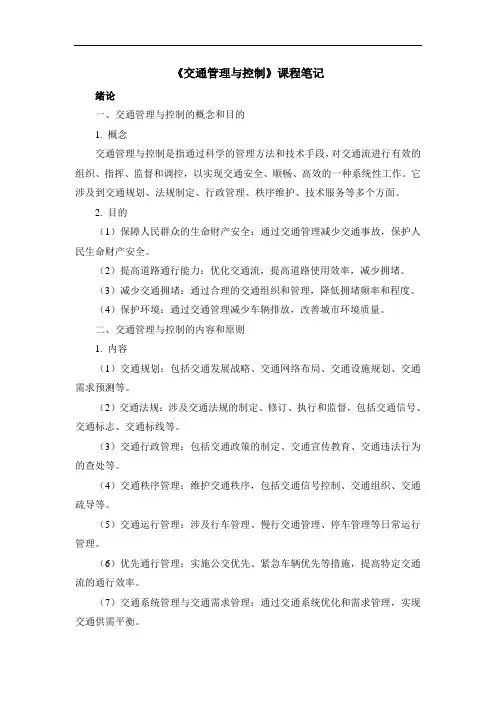
《交通管理与控制》课程笔记绪论一、交通管理与控制的概念和目的1. 概念交通管理与控制是指通过科学的管理方法和技术手段,对交通流进行有效的组织、指挥、监督和调控,以实现交通安全、顺畅、高效的一种系统性工作。
它涉及到交通规划、法规制定、行政管理、秩序维护、技术服务等多个方面。
2. 目的(1)保障人民群众的生命财产安全:通过交通管理减少交通事故,保护人民生命财产安全。
(2)提高道路通行能力:优化交通流,提高道路使用效率,减少拥堵。
(3)减少交通拥堵:通过合理的交通组织和管理,降低拥堵频率和程度。
(4)保护环境:通过交通管理减少车辆排放,改善城市环境质量。
二、交通管理与控制的内容和原则1. 内容(1)交通规划:包括交通发展战略、交通网络布局、交通设施规划、交通需求预测等。
(2)交通法规:涉及交通法规的制定、修订、执行和监督,包括交通信号、交通标志、交通标线等。
(3)交通行政管理:包括交通政策的制定、交通宣传教育、交通违法行为的查处等。
(4)交通秩序管理:维护交通秩序,包括交通信号控制、交通组织、交通疏导等。
(5)交通运行管理:涉及行车管理、慢行交通管理、停车管理等日常运行管理。
(6)优先通行管理:实施公交优先、紧急车辆优先等措施,提高特定交通流的通行效率。
(7)交通系统管理与交通需求管理:通过交通系统优化和需求管理,实现交通供需平衡。
(8)特殊事件交通管理:针对节假日、大型活动、突发事件等特殊情况下的交通管理。
(9)交通拥挤管理:通过多种手段缓解和预防交通拥堵。
(10)交通信号控制:设计和优化交通信号控制系统,提高路口通行效率。
2. 原则(1)科学性:基于交通工程学、心理学、管理学等科学理论进行交通管理。
(2)系统性:将交通视为一个整体系统,协调各组成部分,实现最优运行。
(3)预见性:根据交通发展趋势,提前规划和管理,避免问题的发生。
(4)灵活性:根据实际情况调整管理策略,应对不同交通问题。
(5)公正性:确保交通法规的公平执行,保障各方合法权益。
交通工程实习日记范文5篇
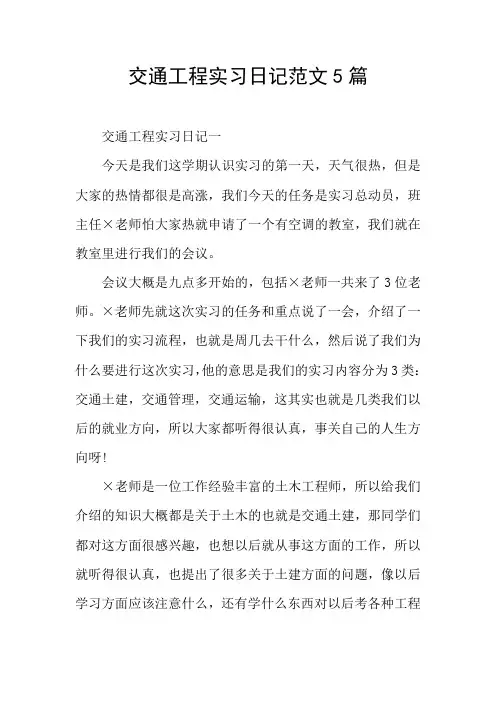
交通工程实习日记范文5篇交通工程实习日记一今天是我们这学期认识实习的第一天,天气很热,但是大家的热情都很是高涨,我们今天的任务是实习总动员,班主任×老师怕大家热就申请了一个有空调的教室,我们就在教室里进行我们的会议。
会议大概是九点多开始的,包括×老师一共来了3位老师。
×老师先就这次实习的任务和重点说了一会,介绍了一下我们的实习流程,也就是周几去干什么,然后说了我们为什么要进行这次实习,他的意思是我们的实习内容分为3类:交通土建,交通管理,交通运输,这其实也就是几类我们以后的就业方向,所以大家都听得很认真,事关自己的人生方向呀!×老师是一位工作经验丰富的土木工程师,所以给我们介绍的知识大概都是关于土木的也就是交通土建,那同学们都对这方面很感兴趣,也想以后就从事这方面的工作,所以就听得很认真,也提出了很多关于土建方面的问题,像以后学习方面应该注意什么,还有学什么东西对以后考各种工程师证件有用(大家都知道证件对一个土木工作者的意义)等。
×老师都用他丰富的经验给了我们满意的答复,还不是问大家还有什么问题,大家一时也想不出有什么问题,就都说以后想起来了在向老师请教。
×老师到后来给我们介绍了其他两位老师的身份,那两位老师分别是×××老师和×××老师。
×老师也是一位兢兢业业的土木工作者,而且她说了一句很关键的话:我们土木工作者其实就是古代的匠人,是为人民服务的人,所以大家都对自己的行为负起责任来。
我觉得这句话说得很到位,因为现在有很多土木工作者都做得有点过分,不对人民的生命财产负责。
所以我们要做向老师们一样的人。
后来,杨老师也做了自我介绍,并对我们的工作做出了指示。
交通工程实习日记二今天我们的任务是学习交通工程的些许知识,说实话我对交通工程一直都处于朦胧状态,虽然我学的专业就叫交通工程。
《交通工程学》课程笔记
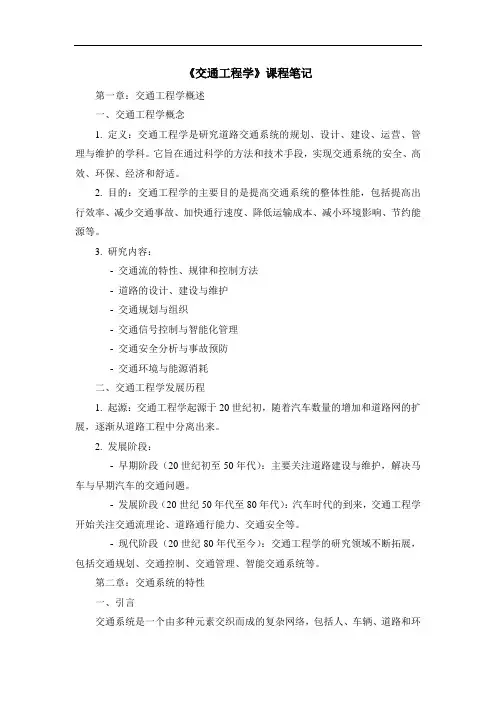
《交通工程学》课程笔记第一章:交通工程学概述一、交通工程学概念1. 定义:交通工程学是研究道路交通系统的规划、设计、建设、运营、管理与维护的学科。
它旨在通过科学的方法和技术手段,实现交通系统的安全、高效、环保、经济和舒适。
2. 目的:交通工程学的主要目的是提高交通系统的整体性能,包括提高出行效率、减少交通事故、加快通行速度、降低运输成本、减小环境影响、节约能源等。
3. 研究内容:- 交通流的特性、规律和控制方法- 道路的设计、建设与维护- 交通规划与组织- 交通信号控制与智能化管理- 交通安全分析与事故预防- 交通环境与能源消耗二、交通工程学发展历程1. 起源:交通工程学起源于20世纪初,随着汽车数量的增加和道路网的扩展,逐渐从道路工程中分离出来。
2. 发展阶段:- 早期阶段(20世纪初至50年代):主要关注道路建设与维护,解决马车与早期汽车的交通问题。
- 发展阶段(20世纪50年代至80年代):汽车时代的到来,交通工程学开始关注交通流理论、道路通行能力、交通安全等。
- 现代阶段(20世纪80年代至今):交通工程学的研究领域不断拓展,包括交通规划、交通控制、交通管理、智能交通系统等。
第二章:交通系统的特性一、引言交通系统是一个由多种元素交织而成的复杂网络,包括人、车辆、道路和环境等。
二、驾驶人的交通特性1. 驾驶员的生理特性- 视觉特性:- 视野范围:驾驶员在不转动头部的情况下所能看到的空间范围。
- 视力:驾驶员对物体细节的辨识能力,包括远视力和夜视力。
- 色觉:驾驶员对颜色的辨识能力,尤其是交通信号灯的颜色。
- 暗适应:驾驶员在光线暗淡条件下的视力适应能力。
- 视觉疲劳:长时间驾驶导致的视觉疲劳现象及其影响。
- 听觉特性:- 听力范围:驾驶员对不同频率声音的听觉敏感度。
- 声音识别:驾驶员对各种声音来源的辨识能力。
- 噪声影响:交通噪声对驾驶员注意力和判断力的影响。
- 反应特性:- 反应时间:从驾驶员感知到刺激到做出反应的时间间隔。
第一章交通工程学
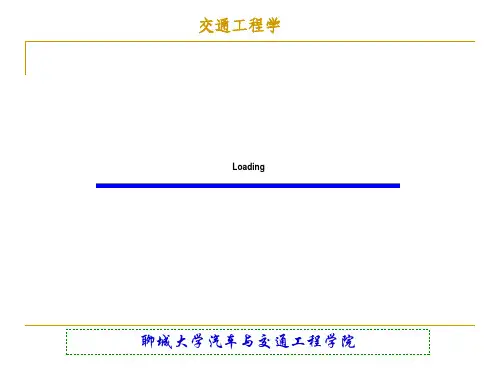
交通工程学
二. 交通工程学的主要作用
1.促进道路交通综合治理方案的形成和实施,促使 交通事故全面下降。 2.有效地减少和避免交通拥挤、混乱状况,提高交 通运输效率和运输企业的经济效益。 3.达到既提高道路通行能力又减轻驾驶员劳动强度 的效果;通过对驾驶员交通心理及生理特性的研 究和运用,实施对驾驶员的科学管理,提高安全 驾驶率。
“抬起头” “竖起耳朵” “睁大眼睛” “动起脑” “做笔记”
聊城大学汽车与交通工程学院
交通工程学
4.参考资料
《交通工程学(第二版)》,李作敏编著,人民 交通出版社,2000年。 《交通工程总论》,徐吉谦编著,人民交通出版 社,2000年。 《交通工程学)》,李江编著,人民交通出版社, 2003年。
聊城大学汽车与交通工程学院
交通工程学
1. 交通现象(交通问题) 交通阻塞 交通安全 交通控制、管理 交通规划
聊城大学汽车与交通工程学院
交通工程学
(1)交通阻塞
聊城大学汽车与交通工程学院
交通工程学
聊城大学汽车与交通工程学院
交通工程学
(2)交通安全
聊城大学汽车与交通工程学院
交通工程学
(3)交通控制、管理
聊城大学汽车与交通工程学院
交通工程学
(4)交通规划
聊城大学汽车与交通工程学院
交通工程学
聊城大学汽车与交通工程学院
交通工程学
课程介绍 1.课程性质:
《交通工程学》是交通运输专业的主要专业核心基础 课。本课程主要以道路交通系统为研究对象。(考研 科目)
2.本课程的学习目的:
通过对本课程学习,应深入了解我国的交通现状及存 在的问题,为使人、车、路、环境和能源这个交通系 统安全、方便、迅速、经济、低公害和环境相协调, 必须牢固掌握一些重要的交通流理论,并逐渐培养和 提高自己分析、解决实际问题的能力,同时为后续课 程的学习打下必要基础。
2024年年一建市政学霸笔记(大纲改版版本)
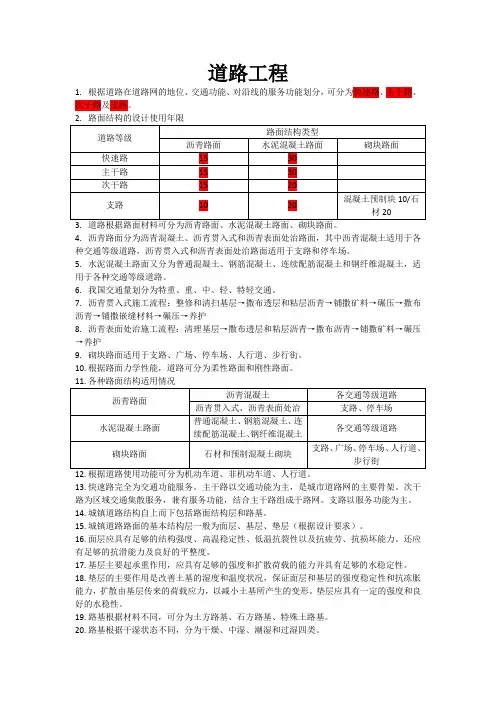
道路工程1.根据道路在道路网的地位、交通功能、对沿线的服务功能划分,可分为快速路、主干路、次干路及支路。
4.沥青路面分为沥青混凝土、沥青贯入式和沥青表面处治路面,其中沥青混凝土适用于各种交通等级道路,沥青贯入式和沥青表面处治路面适用于支路和停车场。
5.水泥混凝土路面又分为普通混凝土、钢筋混凝土、连续配筋混凝土和钢纤维混凝土,适用于各种交通等级道路。
6.我国交通量划分为特重、重、中、轻、特轻交通。
7.沥青贯入式施工流程:整修和清扫基层→撒布透层和粘层沥青→铺撒矿料→碾压→撒布沥青→铺撒嵌缝材料→碾压→养护8.沥青表面处治施工流程:清理基层→撒布透层和粘层沥青→撒布沥青→铺撒矿料→碾压→养护9.砌块路面适用于支路、广场、停车场、人行道、步行街。
10.根据路面力学性能,道路可分为柔性路面和刚性路面。
12.根据道路使用功能可分为机动车道、非机动车道、人行道。
13.快速路完全为交通功能服务。
主干路以交通功能为主,是城市道路网的主要骨架。
次干路为区域交通集散服务,兼有服务功能,结合主干路组成干路网。
支路以服务功能为主。
14.城镇道路结构自上而下包括路面结构层和路基。
15.城镇道路路面的基本结构层一般为面层、基层、垫层(根据设计要求)。
16.面层应具有足够的结构强度、高温稳定性、低温抗裂性以及抗疲劳、抗损坏能力。
还应有足够的抗滑能力及良好的平整度。
17.基层主要起承重作用,应具有足够的强度和扩散荷载的能力并具有足够的水稳定性。
18.垫层的主要作用是改善土基的湿度和温度状况,保证面层和基层的强度稳定性和抗冻胀能力,扩散由基层传来的荷载应力,以减小土基所产生的变形。
垫层应具有一定的强度和良好的水稳性。
19.路基根据材料不同,可分为土方路基、石方路基、特殊土路基。
20.路基根据干湿状态不同,分为干燥、中湿、潮湿和过湿四类。
21.高液限黏土、高液限粉土、含有机质的细粒土不适于做路基填料,因条件限制必须采用时,应掺入石灰或水泥等结合料进行改善。
公路工程管理与实务考前笔记
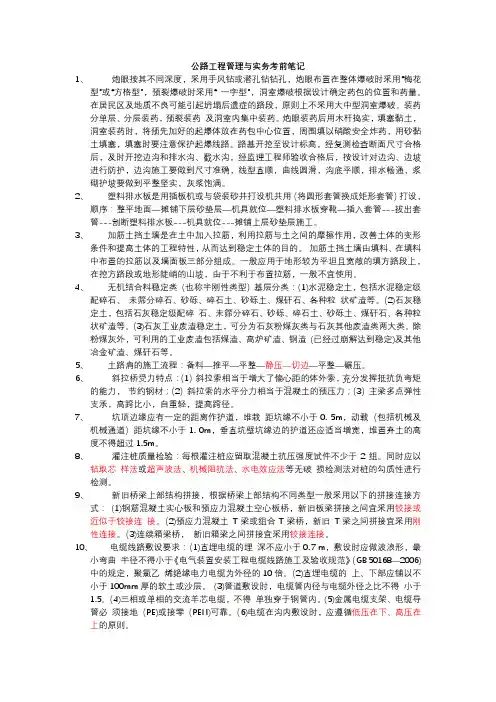
公路工程管理与实务考前笔记1、炮眼按其不同深度,采用手风钻或潜孔钻钻孔,炮眼布置在整体爆破时采用“梅花型”或“方格型”,预裂爆破时采用“一字型”,洞室爆破根据设计确定药包的位置和药量。
在居民区及地质不良可能引起坍塌后遗症的路段,原则上不采用大中型洞室爆破。
装药分单层、分层装药,预裂装药及洞室内集中装药。
炮眼装药后用木杆捣实,填塞黏土,洞室装药时,将预先加好的起爆体放在药包中心位置,周围填以硝酸安全炸药,用砂黏土填塞,填塞时要注意保护起爆线路。
路基开挖至设计标高,经复测检查断面尺寸合格后,及时开挖边沟和排水沟、截水沟,经监理工程师验收合格后,按设计对边沟、边坡进行防护,边沟施工要做到尺寸准确,线型直顺,曲线圆滑,沟底平顺,排水畅通,浆砌护坡要做到平整坚实,灰浆饱满。
2、塑料排水板是用插板机或与袋装砂井打设机共用(将圆形套管换成矩形套管)打设,顺序:整平地面—摊铺下层砂垫层—机具就位—塑料排水板穿靴—插入套管---拔出套管---割断塑料排水板---机具就位---摊铺上层砂垫层施工。
3、加筋土挡土墙是在土中加入拉筋,利用拉筋与土之间的摩擦作用,改善土体的变形条件和提高土体的工程特性,从而达到稳定土体的目的。
加筋土挡土墙由填料、在填料中布置的拉筋以及墙面板三部分组成。
一般应用于地形较为平坦且宽敞的填方路段上,在挖方路段或地形陡峭的山坡,由于不利于布置拉筋,一般不宜使用。
4、无机结合料稳定类(也称半刚性类型)基层分类:(1)水泥稳定土,包括水泥稳定级配碎石、未筛分碎石、砂砾、碎石土、砂砾土、煤矸石、各种粒状矿渣等。
(2)石灰稳定土,包括石灰稳定级配碎石、未筛分碎石、砂砾、碎石土、砂砾土、煤矸石、各种粒状矿渣等。
(3)石灰工业废渣稳定土,可分为石灰粉煤灰类与石灰其他废渣类两大类。
除粉煤灰外,可利用的工业废渣包括煤渣、高炉矿渣、钢渣(已经过崩解达到稳定)及其他冶金矿渣、煤矸石等。
5、土路肩的施工流程:备料—推平—平整—静压—切边—平整—碾压。
《交通管理与控制》大学笔记
《交通管理与控制》大学笔记第一章:导论一、交通管理与控制概述1. 定义:交通管理与控制是一种综合性活动,它通过科学的管理手段和技术措施,对交通流进行有效的引导、调节和监督,以确保交通系统的高效、安全、环保和可持续发展。
2. 目的:- 提高道路通行效率,减少交通拥堵。
- 保障行车和行人安全,降低交通事故发生率。
- 节省能源消耗,减少环境污染。
- 提升交通服务水平,满足人民群众出行需求。
3. 范畴:- 交通规划:长期和短期的交通系统规划。
- 交通设计:道路、交叉口、交通设施的设计。
- 交通组织:交通流线的规划和实施。
- 交通控制:信号控制、交通诱导、交通管制。
- 交通服务:信息服务、紧急救援、停车管理。
二、交通管理与控制的发展历程1. 传统阶段:- 特点:主要依靠增加道路基础设施来满足交通需求。
- 不足:忽视了交通管理的有效性,导致道路资源浪费和环境污染。
2. 现代阶段:- 特点:开始重视交通系统的管理,采用科学的方法进行交通规划和控制。
- 成就:交通流量分配趋于合理,交通拥堵得到一定程度的缓解。
3. 智能化阶段:- 特点:利用信息技术、通信技术和自动控制技术,实现交通系统的智能化管理。
- 趋势:智能交通系统(ITS)的发展,如智能信号控制、车联网、自动驾驶等。
三、交通管理与控制的基本任务与目标1. 基本任务:- 分析交通需求,优化交通流结构。
- 制定交通政策和规划,指导交通建设和发展。
- 组织交通流,提高道路通行能力。
- 实施交通控制,保障交通秩序。
- 监测交通状况,及时处理交通事故和突发事件。
2. 目标:- 实现交通供需平衡,减少交通拥堵。
- 提高交通系统的安全性和可靠性。
- 降低交通对环境的影响,促进绿色出行。
- 提升交通服务的质量和效率。
四、交通管理与控制的主要内容及方法1. 主要内容:- 交通规划:包括交通需求预测、网络规划、交通政策制定等。
- 交通设计:考虑道路线形、交叉口设计、交通标志和标线等。
traffic engineering读书笔记
PrefaceThe text is organized in four major functional parts:Part I: Components(要素) of the Traffic System(2-6)Part 11: Traffic Studies and Programs(7-11)Part 111: Applications to Freeway and Rural Highway Systems(12-15)Part IV Applications to Urban and Suburban Street Systems(16-27)1 交通工程概述2 道路使用者和车辆特性3 道路及其几何特性4 交通控制装置概述5 交通流特性6 智能运输系统7 统计在交通工程中的应用8 交通量研究及特性9 速度和运行时间及延误研究10 交通事故研究和统计11 停车特性及设施12 高速公路和多车道公路的通行能力与服务水平分析13 高速公路及多车道公路的交织及分流合流14 双向双车道乡村公路15 高速公路及乡村公路的信号标志16 交叉口控制概述17 交叉口信号控制基本原理18 信号配时与设计基础19 交叉口设计元素及方案20 实际信号控制和检测21 信号控制交叉口分析22 信号控制交叉口分析的应用23 无信号控制交叉口分析24 干线及网络的信号协调25 干线性能分析26 干线规划与设计27 城市道路网络交通规划与运营1 Introduction to traffic engineering1.1 conceptionsTransportation engineering(交通运输系统)is the application of technology and scientific principles to the planning, functional design, operation, and management of facilities for any mode of transportation in order to provide for the safe, rapid, comfortable, convenient, economical, and environmentally compatible movement of people and goods.Traffic engineering(交通工程)is that phase of transportation engineering which deals with the planning, geometric design and traffic operations of roads, streets, and highways, theirnetworks, terminals, abutting lands, and relationships with other modes of transportation.1.1.1 safety-the primary objectiveDUI(driving under the influence)酒驾DWI(driving while intoxicated)醉后驾驶1.1.2 other objectivesSpeed/comfort/convenience/economy/environmental compatibility1.1.3 responsibility, ethics, and liability in traffic engineeringapply the most current standardsan complete analysisdue carenot arbitrary1.2 transportation system and its functiona major component of the country's economy and have an enormous impact on the shape of the society and the efficiency of the economy1.2.1 the nature of transportation demand1.2.2 concepts of mobility and accessibilityIn highway systems,mobility is provided by high-type facilities, such as freeways, expressways, and primary and secondary arterials. Accessibility is generally provided by local street networks.A good transportation system must provide for both mobility and accessibility and should be designed to s eparate the functions to the extent possible to ensure both safety and efficiency.1.2.3 people, goods, and vehicles1.2.4 transportation modes城市、城际客运、货运系统(各种运输模式,如汽车、公交、火车、火车等)1.3 highway legislation and history in America1700s 私人道路1811 第一条national pike(联邦政府管理)1832 Supreme Court决定由各个州自己管理道路1916, 1934,1944,1956, 1970, 1983 Federal-Aid Highway Act1998 Transportation Equity Act for the 21st Century (TEA-21)central business districts (CBD)1.4 elements of traffic engineering1.Traffic studies and characteristics2.Peirformance evaluation3.Facility design4.Traffic control is a central function of traffic engineers and involves the establishment of traffic regulations and their communication to the driver through the use of traffic control devices, such as signs, markings, and signals.5.Traffic operations involves measures that influence overall operation of traffic facilities, such as one-way street systems, transit operations, curb management, and surveillance and network control systems.6.Transportation systems management optimizing, strategies7.Integration of intelligent transportation system(ITS) technologies refers to the application of modern telecommunications technology to the operation and control of transportation systems. Such systems include automated highways, automated toll-collection systems, vehicle-tracking systems, in-vehicle GPS and mapping systems, automated enforcement of traffic lights and speed laws, smart control devices, and others. This is a rapidly emerging family of technologies with the potential to radically alter the way we travel as well as the way in which transportation professionals gather information and control facilities. While the technology continues to expand, society will grapple with the substantial “big brother” issuesthat such systems invariably create.1.5 modern problems for engineersUrban congestionGrowth managementReconstruction of existing highway facilities also causes unique problemssecurity of transportation facilities1.6 standard reference for engineers权威组织in U.S.1 the Institute of Transportation Engineers (ITE)2 the Transportation Research Board (TRB)交通运输研究委员会TRB is a branch of the National Academy of Engineering and is a major source of research papers and reports.3 The Transportation Group of the American Society of Civil Engineers (ASCE)美国土木工程师学会交通运输组4 ITS America参考书目Tra.c Engineering Handbook [I]Uniform Vehicle Code and Model Trafic Ordinance[2]Manual on Uniform Trafic Control Devices [3]Highway Capacity Manual [4]A Policy on Geometric Design of Highways and Streets[5]参考网站各组织的官方网站2 road user and vehicle characteristics2.1 overview and traffic stream componentsRoad users-drivers, pedestrians, bicyclists, and passengersVehicles-private and commercialStreets and highwaysTraffic control devicesThe general environment2.1.1 dealing with diversity85% percentilelicensing criteria and federal and state standards on vehicle design and operating characteristics.2.1.2 addressing diversity with uniformity2.2 road user个性、心理、视觉、反应对司机而言很重要,而听觉、身体力量等不重要2.2.1 visual characteristics of drivers2.2.2 important visual deficitscataracts, glaucoma, peripheral vision deficits, ocular muscle imbalance, depth perception deficits, and color blindness2.2.3 perception-reaction time(PRT)认知反应时间在不同情况下,不同路段条件下的值不同,The American Association of State Highway and Transportation Officials (AASHTO) mandates the use of 2.5 seconds for most computations involving braking reactionsThe PRT under the “expected”situation was consistently about 0.5 seconds faster than under the “unexpected” situation其他的可能影响PRT的因素有是否酒驾、年龄、性别等2.2.4 pedestrian characteristics步行速度、行人对交通标志的认可以及理解2.2.5 impacts of drugs and alcohol on road usersRecognizing this is important for individuals to ensure safe driving, and is now causing many states to reduce their legal limits on alcohol to0.08%, and for some to consider “zero tolerance” criteria (0.01 %) for new drivers for the first year or two they are licensed.Blood-Alcohol Level(BAC)只有加强教育而别无他法??????2.2.6 impact of aging on road usersIncreased consideration of their needs,particularly in the design and implementation of controldevices and traffic regulations.2.2.7 psychological and personality and related factors“Road rage”is the extreme expression of a driver’s psychological and personal displeasure over the traffic situation he or she has encountered2.3 vehicles2.3.1 concepts of the design vehicle2.3.2 turning characteristics of vehicles2.3.3 braking characteristics2.3.4 acceleration characteristics2.4 total stopping distance and applications2.4.1 safe stopping sight distance2.4.2 decision sight distance2.4.3 other sight distance applications2.4.4 Change (Yellow) and Clearance (All Red) Intervals for a Traff ic SignalThe yellow interval for a traffic signal is designed to allow a velhicle that cannot comfortably stop when the green is withdrawn to enter the intersection legally. Consider the situation shown in Figure 2.5. In Figure 2.5, d is the safe stopping distance. At the time the green is withdrawn, a vehicle at d or less feet from the intersection line will not be able to stop, assuming normal design values hold. A vehicle further away than d would be able to stop without encroaching into the intersection area. The yellow signal is timed to allow a vehicle that cannot stop to traverse distance d at the approach speed (S). A vehicle may legally enter the intersection on yellow.Having entered the intersection legally, the all-red period must allow the vehicle to cross the intersection width (W) and clear the back end of the vehicle (L) past the far intersection line. Thus, the yellow interval must be timed to allow a vehicle to traverse the safe stopping distance. Consider a case in which the approach speed to a signalized intersection is 40 mi/h. How long should the yellow interval be?The safe stopping distance is computed using a standard reaction time of 1.0 s for signal timing and level grade: In actual practice, the yellow interval is computed using a direct time-based algorithm算法and a standard deceleration rate. The principle, however, is the same. This example shows how the concept of safe stopping distance is incorporated into signal timing methodologies, which are discussed in detail in Chapter 20.一英尺等于0.3048米一英里(mi)等于1609米3 roadways and their geometriccharacteristics3.1 highways function and classification3.1.1 trip functionAmerican Association of State Highway and Transportation Officials (AASHTO)美国国家公路与运输协会six distinct travel movements that may be present in a typical trip:Main movementTransitionDistributionCollectionAccessTermination3.1.2 highway classificationLimited-access facilitiesArterialsCollectorsLocal streets3.1.3 preserving the function of a facilityThe importance of providing designs and controls that are appropriate to the intended function of a facility cannot be understated.(主要是通过四种道路的布局分配实现城市期望的运输功能,网格型其实容易造成人车混行,从而造成拥堵)3.2 highway design elements(想想有什么新的东西,记下来,其他的不必记了)3.2.1 introduction to horizontal alignment3.2.2 vertical alignmentLayout 布局3.2.3 introduction to cross-sectional elements3.2.4 surveying and stationing3.3 平曲线3.4 竖曲线3.5 横断面P.I. = point of intersection; point at which theP.C. = point of curvature; point at which theP.T. = point of tangency; point at which theT = length of tangentTS. =transition station from tangent to spiralS.C. =transition station from spiral to circular curveC.S. =transition station from circular curve to spirals.t =transition station from spiral to tangentA =angle of deflection (central angle) of original circular curve without spiral A, = angle of deflection (central angle) of circular portion of curve with spiral4 introduction to traffic control devices4.1 the manual on uniform traffic control devices4.1.1 history and backgroundManual on Uniform Trafic Control Devices (MUTCD)small amounts of blue and yellow pigment have been added to “green” and “red”lenses to enhance their visibility to color-blind drivers.4.1.2 general principles of MUTCDRequirements1. Fulfill a need2. Command attention3. Convey a clear, simple message4. Command respect of road users5. Give adequate time for a proper response4.1.3 contents of MUTCD1. Detailed standards for the physical design of the device, specifying shape, size, colors, legend types and sizes, and specific legend.2. Detailed standards and guidelines on where devices should be located with respect to the traveled way.3. Warrants, or conditions, that justify the use of a particular device.4.1.4 legal respect of MUTCD4.1.5 communicating with driversLegend 文字4.2 traffic marking4.2.1 colours and patterns黄白红绿黑实线禁止变道4.2.2 longitudinal marking4.2.3 transverse marking4.2.4 object makers4.2.5 Delineators (轮廓标)4.3 traffic signsRegulatory signs.Warning signs.Guide signs.4.4 traffic signalsTraffic control signalsEmergency vehicle traffic control signalsTraffic control signals for one-lane, two-wayTraffic control signals for freeway entranceTraffic control signals for moveable bridgesLane-use control signalsFlashing beaconsIn-roadway lights4.5 Special Types of ControlSchool zonesRailroad crossingsConstruction and maintenance zonesPedestrian and bicycle controls4.6 summary and conclusionMUTCD 包含了有关交通控制设施的规定,该规定不断更新,我们可以登录/knomillennium. htm或者5 traffic stream characteristic5.1 types of facilityUninterrupted flowInterrupted flow(更复杂)5.2 traffic stream parametersThe three principal macroscopic(宏观的) parameters that describe a traffic stream are (1) volume or rate of flow, (2) speed, and (3) density.Microscopic(微观的)parameters include(1)the speed of individual vehicles, (2) headway, and (3) spacing.5.2.1 volume and rate of flow124。
六年级上册第13课桥的课堂笔记
六年级上册第13课《桥的课堂笔记》主题:桥的课堂笔记在六年级上册的第13课中,我们学习了关于桥的知识。
桥是连接两个地方的建筑物,它可以帮助人们跨越河流、山谷或其他地形障碍。
这种结构在人类发展史上扮演着非常重要的角色,而学习桥的相关知识也可以帮助我们更好地理解工程学、物理学和历史人文知识。
在桥的课堂笔记中,我们了解到了不同类型的桥梁,比如梁桥、拱桥、悬索桥等。
每种桥梁都有其独特的结构和设计原理,了解这些知识可以帮助我们更好地理解工程学的基础原理。
我们还学习到了我国古代和现代的一些著名桥梁,比如赵州桥、卢沟桥、杭州湾大桥等。
了解这些桥梁的历史和文化背景,可以帮助我们更好地理解历史人文知识。
除了桥梁的类型和历史,我们还学习到了桥梁的构造原理和受力分析。
桥梁是一个复杂的结构,它需要经过精密的设计和计算才能确保安全可靠。
了解桥梁的受力原理可以帮助我们更好地理解物理学知识,比如受力分析、力的平衡等。
学习桥的知识并不仅仅局限于工程学领域,它还涉及到物理学、历史人文知识等多个学科领域。
通过这堂课,我们不仅可以了解桥的基本知识,还可以在学习过程中培养多学科的综合能力。
在我看来,桥梁不仅是一种工程结构,更是人类智慧和勇气的象征。
在人类发展史上,桥梁的建设一直是一个重要的课题,它不仅帮助人们解决了交通问题,还促进了地区经济的发展。
在未来,随着科学技术的不断发展,桥梁建设一定会迎来更加美好的未来,我们也应该为此而努力学习。
通过对六年级上册第13课《桥的课堂笔记》的学习,我们不仅了解了桥的基本知识,还培养了多学科的综合能力。
桥作为一种工程结构,不仅是实用的建筑物,更是人类智慧和勇气的结晶。
希望在未来的学习和生活中,我们可以继续保持对知识的好奇心,不断探索更广阔的学术世界。
以上是我根据你提供的内容撰写的文章,希望能够满足你的要求。
如果需要修改或补充内容,请随时告诉我。
在接下来的学习中,我们将进一步深入研究不同类型的桥梁,并探索其在工程学、物理学和历史人文知识中的应用。
交通规划01.
第5节 交通规划发展历史及现状
交通调查
中国 1981年天津市6个行政区PT调查 1985年北京市首次居民出行调查 机动车OD调查根据需要,间断性、不定期地方性调
查,至今没有进行全国性机动车 OD 调查。 高速公路、主要国道和省道等公路布设断面交通量
观测地点(有间歇式调查和连续式调查两种)。
第5节 交通规划发展历史及现状
第一章 绪论(Introduction)
概述 第1节 第2节 第3节 第4节 第5节 第6节
交通规划的定义 交通规划的分类
#重点
交通规划的内容 交通规划的过程 交通规划的发展历史及现状 交通规划的研究展望
汽车、铁路、轮船 交通运输业
交通运输与社会经济
凡事预则立
第1节 交通规划的定义
1.交通
定义:人和物的地点间、伴随着人的思维意识的 移动。(狭义)
用系统工程理论解决问题的方法称为系统分析。
2.交通规划过程 决策过程
规划执行过程
(战略性过程)
(战术、运营过程)
政府 公共团体 民间团体
交通技术人员 居民
第4节
问题的形成
规划策划的决定 政策、规划案讨论
规划的决定 规划案的实施
交通规划过程
规划对象的信息管理 (交通,社会经济活动,其它)
诊断(发现问题,检查)
规划的种类
规划主体(需求要素):个人,团体;
人、物
规划对象(供给要素):汽车、轨道车
辆、火车、飞机;线路、站场
市场要素:经营管理、收费标准、相关法律等
(1)按移动的对象 (2)按交通方式 (3)按交通设施 (4)按交通服务
公共交通规划;特定用户交通规划 ;特定交通服务规划
- 1、下载文档前请自行甄别文档内容的完整性,平台不提供额外的编辑、内容补充、找答案等附加服务。
- 2、"仅部分预览"的文档,不可在线预览部分如存在完整性等问题,可反馈申请退款(可完整预览的文档不适用该条件!)。
- 3、如文档侵犯您的权益,请联系客服反馈,我们会尽快为您处理(人工客服工作时间:9:00-18:30)。
交通工程学笔记
1第一章绪论
1.1交通工程学的定义、作用及发展
1.2学科内涵、外延、性质与特点
1.3交通工程学的发展
2第二章交通特性分析
2.1道路交通三要素特性
1.驾驶人的职责和要求
2.驾驶人的反应操作过程1.视力
1.视觉
2.视野
3.色感
2.反映特性
3.驾驶人的生理心理特征 1.动机
驾驶人的交通特性
2.素养
3.驾驶人的心理和个性特色3.注意力
4.智力
5.情绪
6.成熟性
7.知识性
8.条件反射
2.2交通量基本特性
2.2.1交通量的定义
交通量:是指在选定时间内,通过道路某一地点或某一断面或者某条车道的交通实体数。
按交通类型分为:a.机动车交通量;b.非机动车交通量;c.行人交通量。
一般不加说明则指机动车交通量,且指来往两个方向的车辆数。
Qi——各规定时间内的日交通量(辆/d)
n——各规定时间段内的时间(d)
[1]年平均日交通量:
365
1
112
36512
i
AADT Qi
=
==
∑个月的月平均日交通量总和
[2]月平均日交通量:
1
MADT=
个月的交通量总和
本月的天数
[3]周平均日交通量:
7
1
1
7
i WADT Qi
=
=∑
2.2.2交通量的时间分布
[1]月变化
[2]周变化
[3]时变化
2.2.3交通量的空间分布
[1]城乡分布
[2]在路段上的分布
[3]交通量的方向分布
[4]
2.2.4交通量的构成特性
2.2.5设计小时交通量(及其应用1)1摘自《交通工程学》王炜过秀成等编著
2.3行车速度特性
2.3.1基本定义
[1]地点速度(Spot speed)
[2]行驶速度(Running speed)
[3]运行速度(Operating speed)
[4]行程速度(Overall speed)
[5]临界速度(Critical speed)
[6]设计速度(Design speed)
2.3.2行程速度的统计分布特性
[1]中位速度
[2]85%位速度
[3]15%位速度与速率波动幅度
2.3.3时间平均车速与区间平均车速
[1]时间平均车速
[2]区间平均车速
[3]两者之间的换算
2.4交通流基本特性及其相互关系
2.4.1交通流三参数基本关系
2.4.2速度与密度的关系
2.4.3流量与密度的关系
2.4.4流量与速度的关系
2.5交通密度特性2
2.5.1交通密度的定义
2.5.2车头间距与车头时距
2.5.3交通密度资料的应用
2.6影响车速变化的因素3
2摘自《交通工程学》王炜过秀成等编著
3摘自《交通工程学》王炜过秀成等编著
3第三章交通调查与分析
3.1意义内容及要求
3.2交通量调查
3.3行车速度与密度调查
3.4行车时间与延误调查
3.5其他交通调查
4第四章交通流理论
4.1概述
4.2交通流统计分析特性
4.3排队论的应用
4.4跟驰理论简介
4.5流体动力学模拟理论
5第五章道路通行能力分析
5.1道路通行能力和服务水平
5.2道路路段通行能力
5.3交织区与匝道通行能力
5.4高速公路与匝道连接处通行能力
5.5平面交叉口通行能力
5.6自行车道通行能力
6第六章交通规划
6.1交通规划的定义、类型与程序
6.2交通规划的调查工作
6.3交通规划的预测工作
6.4交通设施体系规划
6.5交通规划评估与效益分析
7第七章停车设施规划
7.1车辆停放设施分类
7.2车辆停放特征与停车调查
7.3停车设施规划
7.4停车场设计
8第八章交通管理与控制
8.1概述
8.2TDM
8.3道路交通法规与标志、标线
8.4交叉口的信号控制
8.5道路交通组织管理
8.6高速道路的交通控制
9第九章道路交通安全
9.1概述
9.2交通事故调查
9.3交通事故分析
9.4交通事故预测与安全评价
9.5交通安全对策与措施
10第十章道路环境保护
10.1概述
10.2道路交通噪声的污染与控制
10.3道路交通排放的污染物及其防治
10.4道路交通振动的防治
10.5道路交通环境影响评价。
